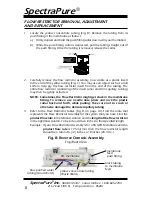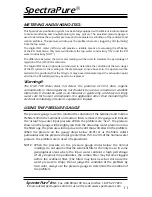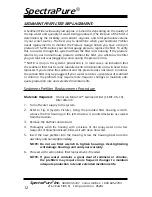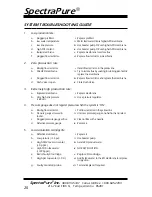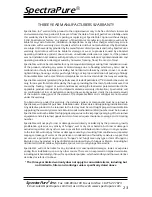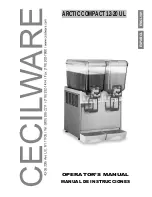
SpectraPure
®
Inc
.
Fax 480.894.6109 Fax us toll-free 1.877.527.7873
E-mail: [email protected] Visit us on the web www.spectrapure.com
15
SpectraPure
®
TESTING THE RO MEMBRANE REJECTION RATE USING
THE TDS METER ON THE LEFT SIDE
PROCEDURE:
1.
First, make sure that the system has been turned on and producing
water (filling the tank) for 5-10 minutes.
2.
Turn the left meter on by depressing the “ON” switch then locate the
slide switch on the front of the meter.
A.
Measure the tap water conductivity by sliding the switch to the Left
“IN”. (Call it X)
B.
Measure RO water conductivity by sliding the switch to the Right
“OUT”. (Call it Y).
C.
Subtract RO water conductivity from tap water conductivity. (X - Y)
D.
Divide this quantity by tap water conductivity. (X - Y) ÷ X
E.
Rejection = [(X - Y) ÷ X ] ×100
*
Conductivity in the above procedure could be caused by hardness,
alkalinity, nitrate, phosphate, silica etc. (The measurement is in ppm
or mg/l).
Rejection of the RO Membrane Calculation Example
1. Tap water hardness = 150 ppm (X)
2. RO water hardness = 7 ppm (Y)
3. X - Y = 143 ppm
4. (X - Y) ÷ X = 143 ÷ 150 = 0.953
5. Rejection = [ ( X - Y) ÷ X ] ×100 = 0.953 ×100 = 95.3
Membrane Hardness Rejection = 95.3 % : Rejection rates less than
95% may indicate that the membrane should be replaced.
As a general rule; the RO membrane would be considered in good
condition when the rejection rate is equal to or greater than 95%.
NOTE:
There are many variables in the input (tap) water chemistry that
may affect the rejection rate of the RO membrane. (If, after testing the
membrane, there are questions regarding its condition, please call our
Technical Support staff for assistance.)








